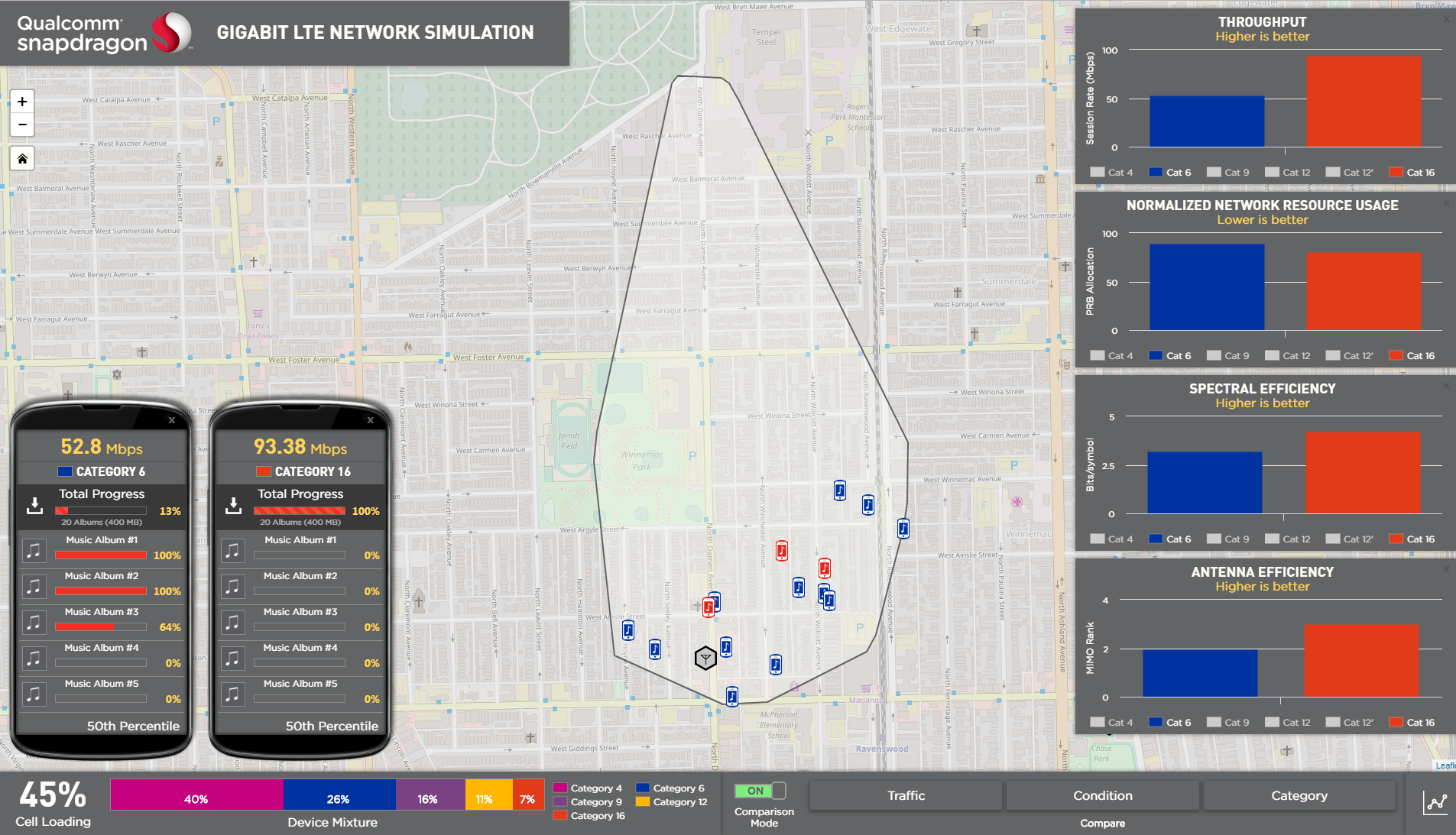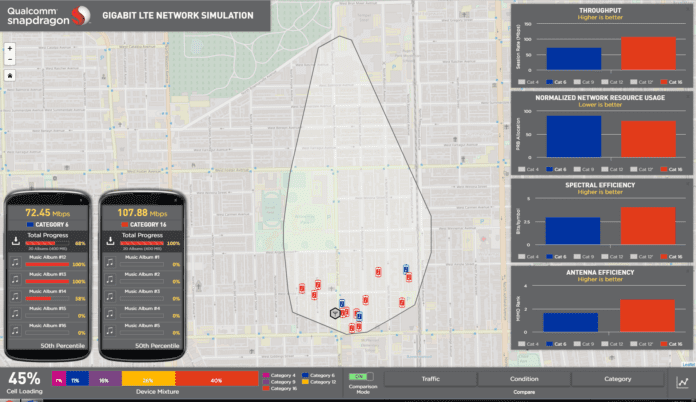4×4 MIMO + carrier aggregation + 256 QAM = gigabit LTE
In what Peter Carson, senior director of marketing, Qualcomm Technologies, dubbed an international “speed race” (pun intended?), all four major U.S. operators, as well as numerous international carriers, are deploying gigabit LTE networks.
Off the top, it’s important to note that gigabit LTE networks are theoretically capable of delivering gigabit-per-second mobile broadband speeds, but, in real world environments, users will see speeds in the in the 100 Mbps-plus range.
Underpinning gigabit LTE are three primary network technologies–all of which will be key to an ultimate 5G New Radio specification and subsequent commercial networks. Those are:
- 4×4 multiple-input, multiple-output (MIMO), which uses four antenna ports at the transmitter and receiver to multiply the capacity of an RF link;
- Carrier aggregation, which effectively joins together non-contiguous bits of radio spectrum, both licensed and unlicensed, into a wider channel;
- And 256 quadature amplitude modulation, a technique that manipulates waveform to allow a higher bit rate per megahertz.
Carson explained these features “are very complementary in their benefits.” Carrier aggregation “has formed the foundation of the path we’re on today. On top of that, more bits per transmission by going from 64 QAM to 256 QAM brings 33% more efficiency in the downlink.”
As carriers deploy these features on live networks, the other important piece is device support. There are six in-market devices that support gigabit LTE. The Samsung Galaxy S8, Galaxy S8+ and MotoZ2 Force Edition, for instance, leverage Qualcomm’s Snapdragon 835 platform and integrated X16 modem, which supports four-channel carrier aggregation, 256 QAM and 4×4 MIMO to enable a Cat 16 user experience.
Carson’s colleague Sherif Hanna, staff manager, technical marketing, used a network visualization tool to show the user-level impact gigabit LTE brings not just to users with Cat 16 device, but to all network users regardless of device.
This graphic shows a network with a device mixture including Cat 4, Cat 6, Cat 9, Cat 12 and Cat 16 devices. For the purposes of the visualization, the emphasis is on Cat 6 and Cat 16 devices with attendant metrics showing throughput, network resource usage, spectral efficiency and antenna efficiency. The device mix below has 26% of total as Cat 6 devices and 7% Cat 16 devices.

The Cat 6 devices have an average downlink throughput of 52.8 Mbps and the Cat 16 devices an average downlink throughput of 93.38 Mbps. The Cat 16 devices have significantly better spectral and antenna efficiency, while, as compared to the Cat 6 devices, network resource usage that’s fairly similar.
Now, flip the device mix to 11% Cat 6 devices and 40% Cat 16 devices.

With this new baseline, average downlink throughput on the Cat 6 devices jumps to 72.45 Mbps and the same metric hits 107.88 Mbps for the Cat 16 devices. “Gigabit LTE is using fewer resources and getting almost double the throughput,” Hanna said, “because the gigabit LTE device is more efficient” in terms of spectral use and bit per second per hertz.
“The operators have been putting a device at the forefront” of gigabit LTE launches, Hanna continued. “In each case the operator is trying to highlight a device that will give their network an edge. It’s also related to the marketing claims they can make. For the operators relying on crowd sourced data, it is in their best interest to get these advanced devices into the hands of the users running these speed tests. It will show the network better. It is definitely in the interest of the operator to seed the devices into the network both for marketing claims and for actual capacity. Anything that can help them improve network efficiency will help them cope with network capacity related to unlimited data plans.”
To restate that, gigabit LTE has an impact on operators’ businesses that touches everything from marketing claims and device subsidization to the ability to support unlimited offerings and spectrum and network investment strategy. Essentially, more advanced devices means a better network experience for all device users.
Sprint is investing in 4×4 MIMO, 256 QAM and three-channel carrier aggregation using 60 megahertz of 2.5 GHz spectrum to support Cat 16 LTE speeds, Adrienne Norton of Sprint corporate communications–network told RCR Wireless News.
She continued, addressing the point that gigabit LTE passes on benefits to all network users: “With the addition of 4×4 MIMO we increase the bandwidth available to customers enabling them to get on and off the network faster, thereby creating more room for others. Three-channel carrier aggregation also adds more capacity to the network improving average speeds for everyone (to reach the peak speed though that 3CA can deliver, you need a 3CA capable device). Also, with the addition of 256 QAM in the downlink we increase spectral efficiency and again make more room for more data to more users.”
Lian Jye Su, ABI Research senior analyst and Dimitris Mavrakis, ABI’s research director, provided additional context. “Both operators and vendors are embracing gigabit LTE. Operator capital expense is under pressure and gigabit LTE network upgrades will certainly be deployed by the main LTE vendors, thus providing a secure–albeit incremental–revenue stream.” For users, video buffering time goes down, as will the time it takes for any sort of file to download of upload. App developers can create new “the next wave of applications,” they wrote.
“There’s also another, not widely discussed benefit of gigabit LTE: it frees up network resources. End-user behavior is not expected to change dramatically before the new wave of applications (e.g., virtual reality) enters the mass market. The high throughput of gigabit LTE enables quick access to whatever users need in a shorter time and thus frees up valuable network resources, increases network capacity and reduces network congestion. The overall system spectral efficiency is then optimized, providing a better experience to more users on the same network. This positive experience improves operators’ brand image, enhances customer loyalty and lowers churn.”
And that’s why gigabit LTE is a big deal.

